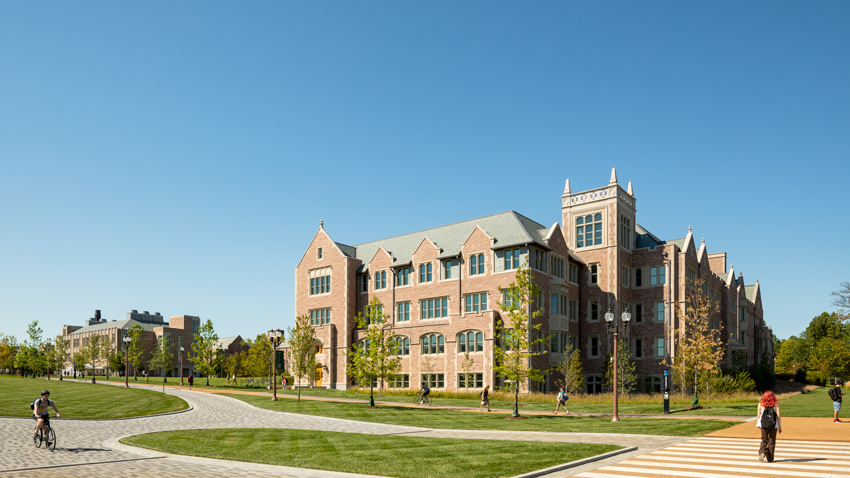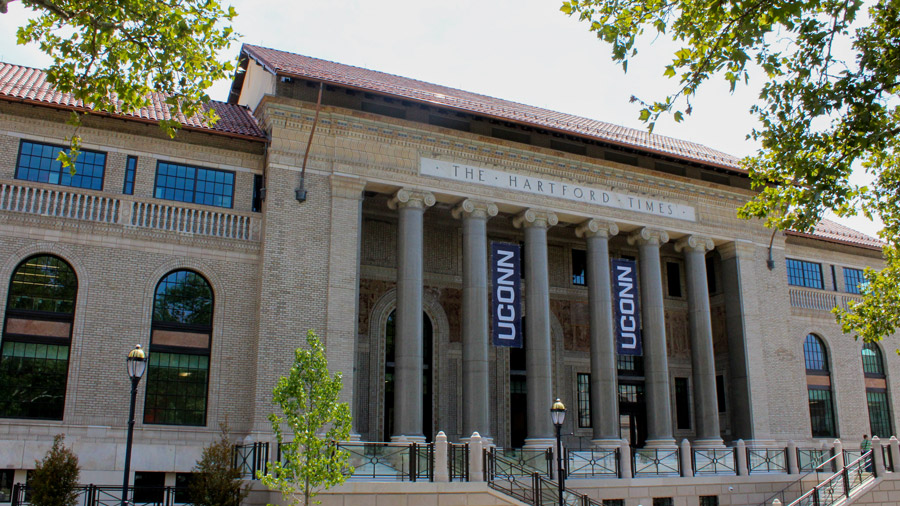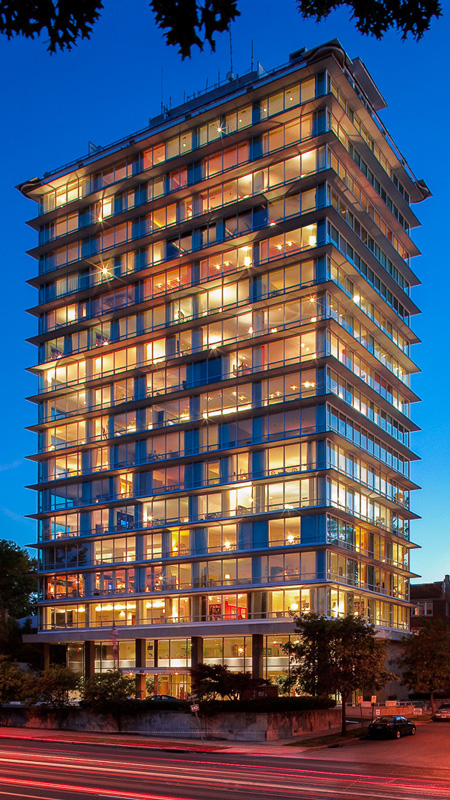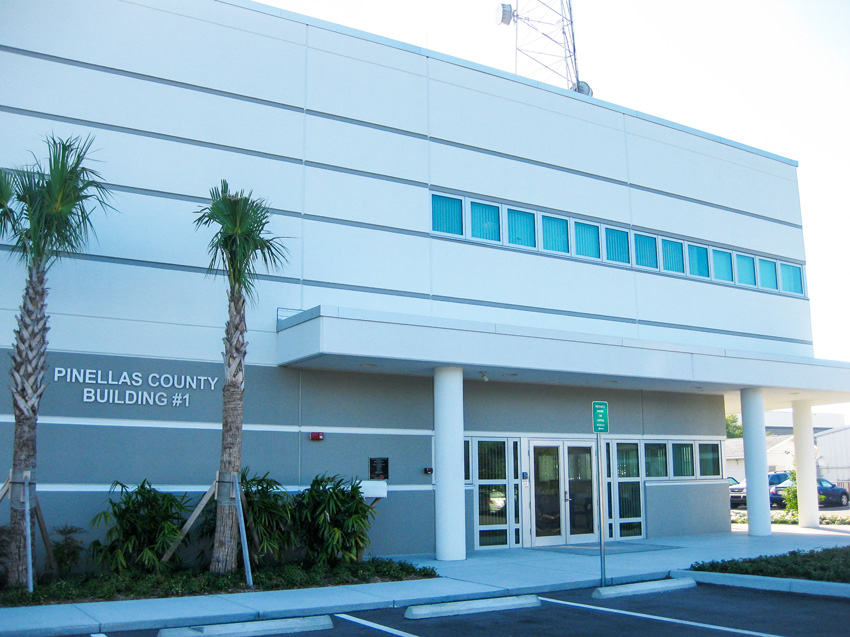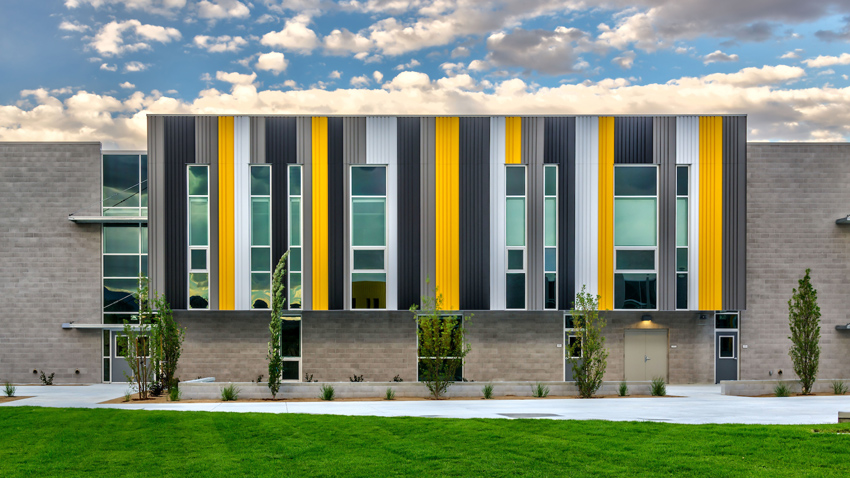Sustainable Architecture: Key Factors to Consider When Selecting Windows
What Makes a Window Sustainable?
Windows Effect on Building Sustainability
U-value indicates the rate of heat flow due to conduction, convection, and radiation through a window because of a temperature difference between the inside and outside. It is the benchmark of comfort and energy savings. The lower the value, the less heat and cold is transmitted. In winter or colder climates, a higher U-factor indicates that more heat is being transferred or “lost” through the window.
To counteract this effect, windows should be well-insulated. There are numerous ways to achieve a superior thermal performance rating of less than 0.35 Btu/Hr-Ft²-°F U-Value (R-Value = 2.9 Hr-Ft²-°F/Btu), including an enhanced window design made of top-tier materials. Possibilities include using multiple layers of glass, referred to as dual, double or triple glazing; the use of low-e window film coatings to reduce the effect of the sun’s intensity; argon gas fill within the gaps between glass panes; thermal edge spacers; thermal breaks; and weather-stripping to prevent air and water infiltration.
Solar Heat Gain Coefficient (SHGC) indicates how much of the sun's energy striking the exterior window is being transmitted through it into the building’s interior as heat gain (i.e., raising the warmth level of a room’s comfort). As the SHGC increases, the solar gain potential through a given window will also increase. This can be ideal in winter or cooler climates, but not so much in warmer seasons or regions.
There are options to help offset the sun’s heat flow through glazing, including using some of the tools to counteract U-Value: type of glazing, color of glass, number of panes, use of gas fill, and low-e window film coatings.
Weather Resistance is another key factor in determining how much sustainable windows will add to a building. Certain needs must be met for varying environments where wind, rain, cold, sun, and seasonal temperature fluctuations come into play. Windows designed for coastal properties must adhere to building codes to withstand high or sustained winds, airborne debris, and torrential rains while windows for colder, Northern climates must be able to adapt to temperature fluctuations when seasons change, as well as protect from cold, snow, and ice melt.
Weather resistance also depends on the type of window installed.
In general, fixed windows are more weather-resistant than operable windows. Their sealed design, without opening mechanisms, minimizes the risk of water infiltration and drafts, providing better protection against the elements. Operable windows, on the other hand, have gaps and seals that can become less effective over time due to use, potentially leading to air and water leakage. In some projects, access to fresh air offered by operable windows may outweigh the weather resistance of fixed windows.
Windows can be constructed to meet various types of weather threats, including window systems that are resistant to tornadoes and hurricanes and meet all applicable building codes and local ordinances. Windows can also be fabricated to help withstand earthquakes. Properly designed windows help preserve installation integrity, making the building more resilient during a seismic event.
Aluminum Finishes
Architects have two key options for adding color to the exterior surfaces of their projects: painting and anodizing. Each method has its own advantages, with factors such as coloration, durability, aesthetics, and cost influencing the decision on which application is most appropriate for a given project.
Anodized aluminum window frames are generally regarded as a more sustainable choice compared to painted frames. This preference is largely due to their extended lifespan, recyclability, and lower environmental impact associated with the anodizing process.
Building Standards
To reduce energy consumption, regional, state and federal governments have adopted rigorous energy standards. Energy codes have become increasingly stringent in recent years, based on the idea that increasing regulation nationwide will ultimately aid in the country’s efforts to reach its national sustainability targets. According to Architecture 2030, roughly 40% of all energy consumption in the United States comes from commercial and residential buildings.2
Sustainable building initiatives such as LEED Certification and WELL Building Standard help architects and designers achieve varying levels of sustainability goals, covering everything from materials sourced, energy efficiency, water conservation, waste material management, air quality, reduced gas emissions, and provisions for an overall healthy environment for occupants.
Window products meet LEED Certification and WELL Building Standard with the materials used to manufacture them and the level of performance that the final window system provides. Window performance is measured by U-value ratings, SHGC ratings, and overall weather resistance. Different materials (e.g., aluminum, fiberglass, vinyl, or wood) react differently to weather and provide different U-Values and SHGC ratings.
Attention to these strict standards has resulted in Winco’s participation in LEED Silver and Gold projects across the country, including multiple buildings at Washington University in St. Louis, an eclectic re-make of a parking garage into apartment living, and a historic adaptation of a cultural landmark in New Orleans.
Sustainable Materials are Key to High-Performance Windows
Recycled Construction Materials
According to the Vinyl Institute, more than 1 billion pounds of PVC/vinyl is recycled annually in the United States and Canada, including 958 million pounds of pre-consumer vinyl materials and 142 million post-consumer vinyl materials.3 However, while vinyl is considered recyclable, the process is complex, with as few as 100 vinyl recycling facilities in the U.S. and Canada. One concern is possible material contamination during processing. If incinerated, vinyl can release harmful chemicals into the air, including chlorine gas. If not recycled, it will end up in a landfill. According to U.S. Environmental Protection Agency statistics, around 1.9 billion pounds of vinyl products are landfilled today in the U.S.
Due to its composite nature, fiberglass is even less commonly recycled. There are fewer recycling facilities capable of processing it, so it often languishes in landfills.
Most recycling centers accept aluminum for recycling. It is highly recyclable and can be processed multiple times over without losing quality. When it comes to recyclability, aluminum is the clear winner.
Aluminum: Nature’s Efficient Resource
Aluminum manufacturing is a sustainable industry that continues to reduce its carbon impact by making improvements in how it is produced, recycled, and reused. According to the Aluminum Association4, the United States aluminum industry has:
- • Lowered greenhouse gas (GHG) emissions by 59% since 2005.
- • Reduced energy consumption by 55% since 1998.
- • Decreased primary aluminum carbon intensity by 49% since 1991.
According to the Aluminum Association, approximately 75% of all aluminum ever produced in the United States is still in use, largely due to effective recycling practices.5 When it comes to aluminum recycling, cans are top of mind; however, there is a wide range of aluminum materials that are recycled, including foil, wheel rims, extrusions from construction (e.g., window frames, door frames, gutters, siding), manufacturing scrap, electronics, and packaging. Recycled aluminum is collected and processed into new aluminum products.
Durability and Lifespan
Windows that are designed to last are not only a great investment but also save on resources.
When it comes to product durability and lifespan, aluminum and fiberglass window frames go toe-to-toe. Both are extremely durable.
Fiberglass window frames resist warping, expanding, or contracting due to temperature fluctuations. Fiberglass also resists corrosion, moisture, and pest damage and provides a 40 to 50-year lifespan6.
Aluminum window frames are impact-resistant and resist warping and bending. When treated with a protective coating such as powder-coated paint or an anodized finish, aluminum resists corrosion from moisture and withstands harsh weather conditions, including rain, snowstorms, and extreme temperatures. Most aluminum frames can last 20 to 40 years, especially with a protective finish, appropriate installation, quality sealants and routine maintenance.7
By comparison, vinyl window frames are only moderately durable, resisting corrosion, rot, and insect damage. They have a shorter lifespan of just 20 to 40 years8 and may not be the best choice for very cold climates as the material can become brittle over time.
For projects where new windows are not economically feasible and the current ones still provide some energy efficiency, the original windows can be retained with the addition of a blind sash insert. This will help improve the energy efficiency of the original windows, making this option a win-win for building owners and the environment.
Typical insulated glass units inherently have a limited lifespan because the hermetic seal is constantly under attack from weather and barometric pressure. Non-sealed dual glazed glass can be used with a blind sash resulting in a unit that cannot fail. If there is breakage to either the interior or exterior lite, the replacement is easier and does not require temporary boarding-up of the building.
Raw Material Locality
What separates aluminum from fiberglass and vinyl is its composition. Aluminum is mostly a single source material, which adds to its recyclability. Aluminum is primarily sourced from bauxite ore, mined from surface or open-pit mines located in Australia; Guinea, Africa; Brazil; Jamaica; India; and China. Once mined, the bauxite ore is refined into alumina (aluminum oxide) and ready for smelting.
There are many aluminum manufacturing plants in the United States which smelt alumina and recycled aluminum, as well as a robust aluminum window frame manufacturing industry. In the simplest terms, aluminum is a readily available resource nationwide and can be sourced locally.
Fiberglass and vinyl are composite materials consisting of lots of chemicals. Fiberglass window frames are made up of glass fibers, resins, additives, and coatings. These are sourced through a combination of natural extraction, industrial processes, and chemical synthesis and involve multiple manufacturers to process the individual elements.
Vinyl window frames are primarily polyvinyl chloride (PVC) along with stabilizers, pigments, and fillers, which are sourced through a combination of natural extraction, refining, and chemical manufacturing. Considering that ethylene (a derivative of petroleum or natural gas) is a fossil fuel that is the primary raw material of PVC, vinyl is neither a local product nor recyclable.
Both fiberglass and vinyl are manufactured in fewer facilities across the U.S. compared to the number of aluminum manufacturing plants. Because of this, shipping and transportation costs are higher and may require more time to procure. This is just another example of how the use of aluminum window frames helps architects and builders reduce gas emissions and leave a smaller carbon footprint. Where a raw material is sourced correlates to how transportation and efficiency come into play.
Such was the case for the Hartford Times Building at the University of Connecticut. Winco manufactured and factory-glazed our Series 3250 Steel Replication windows in St. Louis, helping reduce expensive field labor and material costs in Connecticut.
Thermal Performance Differences
Energy efficient windows have been around for decades, having been developed like many building materials and products as a response to reduce fuel consumption during the energy crisis of the 1970s. Fuel shortages not only impacted gas for automobiles but also how buildings and homes were heated.
This laid the groundwork for window manufacturers to explore energy conservation techniques. The first consideration is the raw materials used to make the window frame. Vinyl is on the lower end of the sustainability spectrum as its primary raw material comes from petroleum. Fiberglass offers better sustainability due to its long wear and durability. And aluminum is at the highest end of the sustainability spectrum because it is durable, recyclable, and readily available.
After selection of the raw material, the next consideration is how to improve the base material for better final product performance. Here are some of the factors that help improve a window system’s overall insulation, thereby enhancing overall performance.
• low-e window film coatings — reduce the effect of the sun’s intensity and provide solar protection
• argon gas — used to fill in the gaps between glass panes, creating an insulation buffer zone
• thermal edge spacers — insulating components placed between panes of glass to improve energy efficiency by reducing heat transfer
• thermal breaks — insulating barriers integrated into the aluminum window frame design to improve thermal performance. Since aluminum is an excellent heat conductor, thermal breaks made of non-conductive materials such as plastic, vinyl, or fiberglass are inserted between interior and exterior framing components to create thermal bridging.
• weather-stripping — flexible rubber or foam material seals the window frame’s moving parts such as the sash to block out air and water infiltration, reducing drafts and water leakage
• sealants — pliable materials such as caulk or silicone seal the stationary parts of the window frame, as well as where the frame connects to the building’s window opening to prevent air and water infiltration
• built-in blinds- encasing blinds or shades between two panes of glass allows dynamic daylight control either on-site with a wall mounted keypad or remotely through automated integration with a Building Management System.
The above noted components, additions, and enhancements improve a window system’s ability to lower U-values, minimize the SHCG, resist air and water infiltration, ensure energy efficiency, enhance occupant comfort, provide dynamic daylighting control and provide long-lasting wear with minimal maintenance.
Product Longevity and Weather Resistance
Thermal is a crucial measure of overall performance, especially at high elevations or high latitudes or in different types of climates. Severe wind and weather in many regions add another layer of complexity to window performance.
Many areas of the U.S., especially in the mountainous West, are designated by NOAA and FEMA as “Special Wind Regions,” indicative of sustained winds over 54 MPH, gusts over 115 MPH, and property loss over $25M. Most thermal performance testing does not include the air infiltration (or draftiness) of a window assembly as they are sealed shut.
The durability of fiberglass windows in extreme environments is currently undocumented.
Fiberglass windows do not have the design pressure capacity and life-cycle durability to withstand years of thermal stress and water penetration. Also, unlike thermally-broken aluminum window frames with mechanically joined corners, fiberglass corners use fasteners and epoxy, which can add to potential leak issues.
Aluminum frames have been used successfully in extreme weather environments since the 1930’s. They have stood the test of time during blizzards, hurricanes, and even tornadoes, while fiberglass's longevity remains to be seen.
Aluminum frame windows excel in extreme weather conditions for several reasons. A protective paint coating or anodized finish ensures long-lasting wear in harsh climates, prevent moisture-borne corrosion from forming. Thermal breaks made of plastic, vinyl, or fiberglass are used in aluminum frames to create a thermal bridge that slows the transfer of heat between components while thermal edge spacers keep moisture from creeping into the frame’s interior.
Mechanically joined corners provide strength and limit air and water infiltration. Flexible weather-stripping around the sash and other moving parts helps eliminate drafts and leakage, while long-wearing sealants ensure frames are weathertight, especially where the window frames meet up to the building structure openings.
One of our favorite examples of energy efficient windows systems “form-fitting” the job and meeting air, water, and structural requirements is the use of our 1450 Series 4” Deep Unitized Window Wall and 3325 Zero Sightline Vent for the tessellating façade of San Francisco’s Vida Condos.
Another case study highlighting a sustainable window solution is the replacement of a 50-year-old window wall system that was making apartment living truly uncomfortable. Winco provided a window wall system that eliminated drafts, heat loss, and water leakage for the modernist apartment building at 801 South Skinker Boulevard in St. Louis. The end result was a window system that insulates 3.5 times better than the original single-pane windows.
Weather Performance Differences
An often-overlooked aspect of manufacturing sustainable products is ensuring that they meet the high-performance standards for weather-resistance and unexpected catastrophic events. As climate change evolves, window systems, along with other building components, must be built and tested to withstand volatile changes.
Not every window fits every climate. Some areas of the United States endure long, hot dry spells which necessitates windows with low-e coatings for solar protection and interior temperature control for comfort. Coastal areas experience heavier rain seasons, warmer temperatures, and greater storms with higher winds, surging water, and flooding. The Midwest to the South must contend with tornadoes, heavy rains, and hail while Northern and mountainous regions face deep cold, high winds, and heavy, wet snow.
For windows to withstand the rigors of extreme environments, they must be designed with top quality materials and include all the enhancements available for energy efficiency, proper insulation, air and water infiltration prevention, and durability.
Ensuring that windows withstand both natural and man-made threats requires design innovation and product testing for proven results. It’s critical to keep essential facilities such as police, fire, EMS headquarters, storm shelters, and hospitals operating during catastrophic storms, power outages, or man-made attacks.
Making windows that are both sustainable and ensure property security/occupant safety is one of our top priorities. The Pinellas County Emergency Response operations building in Clearwater, Florida, showcases how aesthetically pleasing windows can provide the highest level of protection while also achieving LEED Gold Certification by the United States Green Building Council (USGBC).
Thermal Expansion and Contraction
All building materials expand and contract in shape and size due to fluctuations in temperature. How much change occurs in the size or shape of the window frame depends on the material used and the variance in temperatures.
For instance, because vinyl is a type of plastic, temperature changes have significant effects. Heat causes vinyl window frames to expand, allowing the material to become more flexible and susceptible to warping. During warmer seasons or in hot climates, heat expansion disrupts the integrity of the fit and seal of vinyl window frames. During colder temperatures, vinyl window frames become more rigid and contract, causing gaps to form between the glazing and the framing. Gaps lead to air and water leaks. Repeated cycles of expansion and contraction lead to greater wear and tear, warping, cracking, and even deformation of the material.
While fiberglass windows also experience thermal expansion and contraction, the reaction is quite different.9 Glass has a low coefficient of thermal expansion, so with glass fibers as the primary material in fiberglass, the reaction is roughly the same. As a composite material, fiberglass offers better thermal stability than vinyl, maintaining shape and structural integrity for many years. Whether the environmental conditions are hot or cold, fiberglass reacts with minimal movement, practically eliminating the concerns associated with vinyl window frames. Fiberglass window frames are more sustainable because they tend to resist warping and remain easy to operate in all climates.
As mentioned earlier, aluminum is an excellent heat conductor. Because of this, aluminum window frames would have a significant energy loss if not for incorporating thermal barriers into the design. Knowing that metals like aluminum will expand and contract with temperature fluctuations, design enhancements to the aluminum window frame counteract any potential drawbacks. Also understanding that aluminum expands and contracts, allowances are made when fitting the frames into openings. Thermal breaks, edge spacers, mechanically joined corners, weather-stripping, sealants, and a protective coating all ensure that aluminum frame windows meet performance requirements and provide lasting durability no matter the climate.
Carbon Footprint
Carbon footprint is a term describing the greenhouse gases (GHGs) created from a particular product, and the impact they have on the environment. Regarding sustainability in construction, architects and builders must know and understand the differences between “embodied carbon” and “operational carbon.”
Embodied carbon relates to the product itself, everything from extraction of raw materials to disposal of the product at the end of its lifespan. This includes emissions released when the raw materials are extracted or sourced, the manufacturing process, shipping and transporting both the raw materials and the finished product, and final disposal or recycling. These emissions are incurred while sourcing, manufacturing, and getting the product to where it will be used.
Operational carbon refers to the emissions released when a product is in use, such as heating, cooling, and lighting; and yes, windows do contribute to the overall operational costs of a structure. Windows add value by providing daylighting, allowing occupants to enjoy the warmth and light of the day rather than relying on electricity. Windows also contribute to lowering heating and cooling bills while maintaining a comfortable, draft-free environment.
When deciding what windows to use for a project, architects and builders need to review both the window’s embodied carbon, as well as the operational carbon.
Design Flexibility for Natural Lighting
Another notable aspect of sustainable design is incorporating materials that take advantage of natural resources—specifically the sun. Windows allow sunshine to light up and warm interiors, but sometimes the sun’s intensity can make it too bright or too hot.
Fortunately, architects and builders have an abundance of window design options that address these concerns, from built-in window blinds, low-e and solar protection coatings, thermal breaks to reduce heat loss/gain, and sizing to allow as much sunlight as desired. More advanced technology can provide dynamic daylight control with the use of manual or automated integrated blinds and shades. Often, clients want oversized windows to maximize daylighting. This is made possible while ensuring ambient interior temperatures remain comfortable.
Winco partnered with local architects for the massive renovation of the former shipyard warehouses at San Francisco’s historic Pier 70. Winco engineers created numerous new dies to ensure the new replication windows matched the historic profiles of the original massive windows, and the project has received multiple industry awards.
The Future of Sustainability is Product Innovation
The future of building construction depends on using sustainable materials that meet a multitude of criteria in a single product—energy efficiency, long-lasting durability, end-of-use recyclability, health and safety assurance, and cost-effectiveness.
These goals are attained through product innovation, research, materials and product testing, and compliance with a variety of building standards for performance, energy efficiency, safety and security, and sustainable building initiatives.
Our Transira™ Window Solution
Transira is a window with an automated, high-performance shade or blind, built in between two panes of glass. It can be activated with remote or Building Management System (BMS) integration or local control such as a wall keypad. Occupants have the ability to control visibility, light, and solar heat entering a room at the touch of a button while the systems can prioritize energy efficiency.
The first installation of our Transira Window Solution was at the Nick Poulakidas Elementary School in Reno, Nevada, where this all-in-one window system serves multiple purposes—conserving energy, harvesting daylighting, maintaining comfort, and ensuring safety. Since then, more schools within the district have received the retrofit configuration of the Transira Window Solution, providing existing schools with scalable, cost-effective replacements that are easy to install.
As all building product manufacturers strive for sustainable outcomes, the industry and architects can make a difference in designing a cleaner, healthier environment for all to enjoy.
To see more sustainable window designs, click here. Or, if you’re ready to get started, find your local representative today!
References
1Sustainability in the Architect’s Journey to Specification, published September 2020 by The American Institute of Architects In collaboration with B2B International, Deltek, and Construct Connect.
4 Aluminum Association, (2023), 2023 Aluminum Industry Report. Retrieved from https://www.aluminum.org
5 The Aluminum Association, Retrieved from https://www.aluminum.org/sustainability
6, 7, 8 US Department of Energy (materials and window options) - Fiberglass Windows: Advantages and Lifespan
9 The minimal expansion and contraction properties of fiberglass windows are well documented by manufacturers of fiberglass window manufacturers including Marvin, Pella and Milgard. However, peer reviewed studies are unavailable as of this writing.



